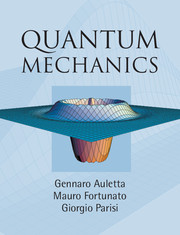Book contents
- Frontmatter
- Contents
- List of figures
- List of tables
- List of definitions, principles, etc.
- List of boxes
- List of symbols
- List of abbreviations
- Introduction
- Part I Basic features of quantum mechanics
- Part II More advanced topics
- Part III Matter and light
- 10 Perturbations and approximation methods
- 11 Hydrogen and helium atoms
- 12 Hydrogen molecularion
- 13 Quantum optics
- Part IV Quantum information: state and correlations
- Bibliography
- Author index
- Subject index
11 - Hydrogen and helium atoms
Published online by Cambridge University Press: 05 June 2012
- Frontmatter
- Contents
- List of figures
- List of tables
- List of definitions, principles, etc.
- List of boxes
- List of symbols
- List of abbreviations
- Introduction
- Part I Basic features of quantum mechanics
- Part II More advanced topics
- Part III Matter and light
- 10 Perturbations and approximation methods
- 11 Hydrogen and helium atoms
- 12 Hydrogen molecularion
- 13 Quantum optics
- Part IV Quantum information: state and correlations
- Bibliography
- Author index
- Subject index
Summary
Introduction
As is well known, the concept of the atom appears for the first time as a hypothesis about the structure of matter by Democritus (c. 460 BC–c. 370 BC). Democritus also proposed a rudimentary mechanics: Atoms moved in straight lines and through their collisions bodies were formed and destroyed. It is also interesting to recall that later Epicurus (341 BC–270 BC) and Lucretius (c. 94 BC–c. 49 BC) introduced a random, reasonless, deviation (clinamen) from the straight line in order to account for the contingency of our world. Though atomism remained a speculative theory for more than 2000 years, in modern ages it was still alive among many scientists and philosophers (Newton, Locke, Spinoza, etc.).
At the beginning of the nineteenth century John Dalton (1766–1844) introduced the concept of the atom in a scientific framework in order to explain some chemical phenomena. He was one of the earliest scientists to work on the structure of matter. He supposed that atoms were the smallest units of an element that enter into chemical combinations, and that a chemical element was composed entirely of one type of atom. Then, compounds contain atoms of two or more different elements, where the relative number of atoms of each element in a particular compound is always the same. Experimentally, he observed that, for each gram of hydrogen found in water there were always 8 grams of oxygen.
- Type
- Chapter
- Information
- Quantum Mechanics , pp. 401 - 438Publisher: Cambridge University PressPrint publication year: 2009



